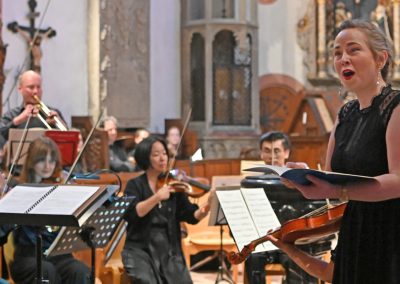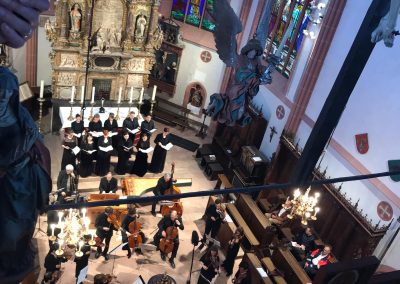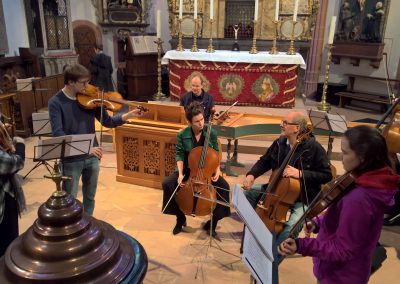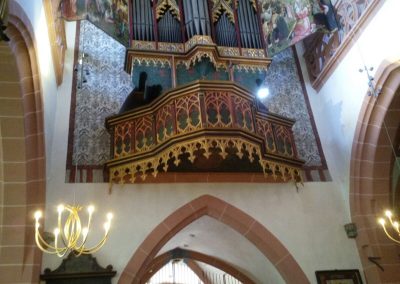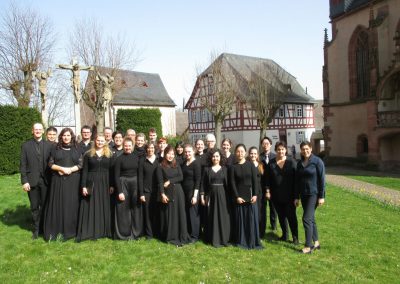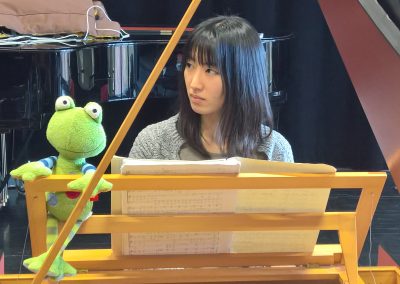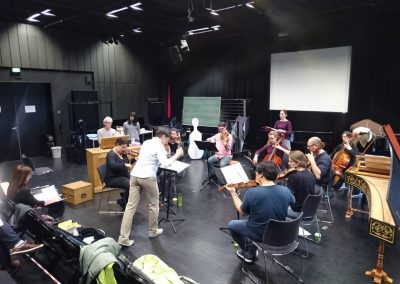Patrons’ Concerts
Introduction
Patrons and music
Outlook
Future concerts
Looking back
Impressions

Patrons’ concerts (Mäzenatenkonzerte)
Blessed have always been those musicians, scientists and artists who found or were found by generous patrons … not rarely their support was vital. Without patronage and financial support through those open-minded persons a lot of treasured pieces of art and music would not have come to exist.
The Gonzaga family in Mantua patronized Claudio Monteverdi and Peter Paul Rubens, the Medici in Florence Botticelli, Donatello and Brunelleschi, Gottfried Freiherr van Swieten supported Mozart, Ludwig II of Bavaria enabled Richard Wagner to erect his Festspielhaus in Bayreuth and to compose Tristan and Isolde. Cardinal Benedetto Pamphili wrote libretti for oratorios and cantata texts and can be reckoned among Handel’s patrons as well as the Duke of Chandos, to whom the famous Chandos Anthems are dedicated. Cardinal Pietro Ottoboni employed the services of exceptional musicians like Alessandro Scarlatti, Bernardo Pasquini, Domenico Scarlatti and George Frederic Handel for private concerts and sponsored quite a number of opera premieres in his private theatre.
The list of famous patrons could be easily continued up to the present, since fortunately they still do exist – individuals who act from conviction and support a multitude of purposes without expecting personal gains.
The Mäzenatenkonzerte (“patrons’ concerts”) were established at the HfM Mainz in 2019. Their aim is to invite baroque music lovers to attend exceptional concerts and to become patrons themselves. Visiting the concerts and donating at the exit provides a wonderful opportunity for everyone to combine indulging in a high-quality musical experience and supporting young musicians! Everybody according to their abilities. Our gratitude is certain!
The Basilica minor St. Valentine at Kiedrich/Rheingau hosts our concerts. By including Kiedrich in our concert venues, the Hochschule für Musik Mainz wishes to pursue the historically evolved connections between the city/bishopric of Mainz and the Rheingau valley.

Outlook

Looking back
Mäzenatenkonzert 2023
In cooperation with the Barockorchester der Hochschule für Musik Trossingen (dir. Prof. Anton Steck, Violine) and supported by a lot of colleagues and Early Music professionals (including excellent baroque trumpeter Casey Reeve) we performed the 4. Mäzenatenkonzert in the Basilica St. Valentine in Kiedrich/Rheingau.
Bach’s Magnificat and his cantata Jauchzet Gott in allen Landen (solo: Emilie Jønsson, soprano and Casey Reeve, trumpet) reounded in the gothic church and were enthusiastically received by the audience.
As our „special guests“ we welcomed for the first time the boys’ choir Kiedricher Chorbuben, who performed Bach’s chorale Zion hört die Wächter singen and the Ave Maria in Gregorian Chant in the rare version of Mainzer Dialekt, which is a melodic veriation of the regular Roman Gregorian Chant.
The concert ended with another highlight: all musicians performing Bach’s final chorale Lobe den Herrn from BWV 137.
We are looking forward to further concerts with the departmant for Baroque Music of Hochschule für Musik Trossingen!
Photos: Hermann Heibel
Mäzenatenkonzert 2021
Concerti sacri of the Early Baroque Era
Vocal and instrumental music by Monteverdi, Cazzati, Grandi, Schütz et al.
Ensemble Suttonia
Elisabeth Scholl, director
One could say that everything started with Claudio Monteverdi. Although there were a number of other contemporary composers who had a share in the birth of a new musical style. They got rid of “stiff” counterpoint and indulged in a fascinating abundance of expressive harmony and melodies. Dissonances and musical effects enriched not only the performances of the newly developed opera, but found their way into church music, too.
From Italy the stile nuovo, the new style conquered whole Europe. Composers like Heinrich Schütz crossed the alps in order to study this new kind of music and brought it back to Germany, in copies of Italian masterpieces and in their own compositions.
Due to COVID regulations, the 3. Mäzenatenkonzert offers music of the early baroque period with a smaller cast. Solo voices and solo instruments mix in little concerti and motets, solos, duets an trios with and without instrumental accompaniment … – the early baroque musical artistry is one of exquisite diversity, full of exciting experiments and promises a delightful sound experience.
Mäzenatenkonzert 2019
Viva Vivaldi! – …encore …
There is a sister to Vivaldi’s Gloria RV 589, the Gloria RV 588. It does share a few parts with its sibling but varies in others extensively. Especially the Introduzione for alto solo is much more demanding in virtuosity than the solo part in RV 589. A very interesting comparison!
Nicola Porpora was one of the foremost singing teachers in Italy at the beginning of the 18th century. He started out as a teacher at Sant’Onofrio conservatory, an orphanage for young boys in Naples and counted Porporino, Caffarelli and Farinelli among his students. Later he got employed by some of the Venetian ospedali as teacher and composer. The manuscript of his Dixit Dominus is very clear about the use of voices: Only sopranos and altos.
Photos: private
Mäzenatenkonzert 2018
Viva Vivaldi!
In 2018 Orchestra & Ensemble Suttonia performed Antonio Vivaldi’s Gloria in D RV589 and his Magnificat RV 610 using only soprano and alto voices. An unusual sound experience without the expected male voices!
Vivaldi composed the pieces originally for one of the Venetian Ospedali, orphanages for girls and young women. But the surviving manuscripts indicate SATB. Musicologists therefore currently debate how Vivaldi performed this music at the Ospedale della pietà. From sources can be concluded that he didn’t engage external male voices. And we do know that there were young women with “vocal chords the size of suspenders” who were able to sing very low parts. But they were an exemption from the rule. So, could one “female bass” have stood up to a bigger vocal ensemble? Or was the vocal bass line played by instruments? And the tenor lines aren’t really comfortable for the average female voice …
We decided to perform the concert only with soprano and alto voices – an experiment, a potential option, a thrilling sound experience!
Photos: private









